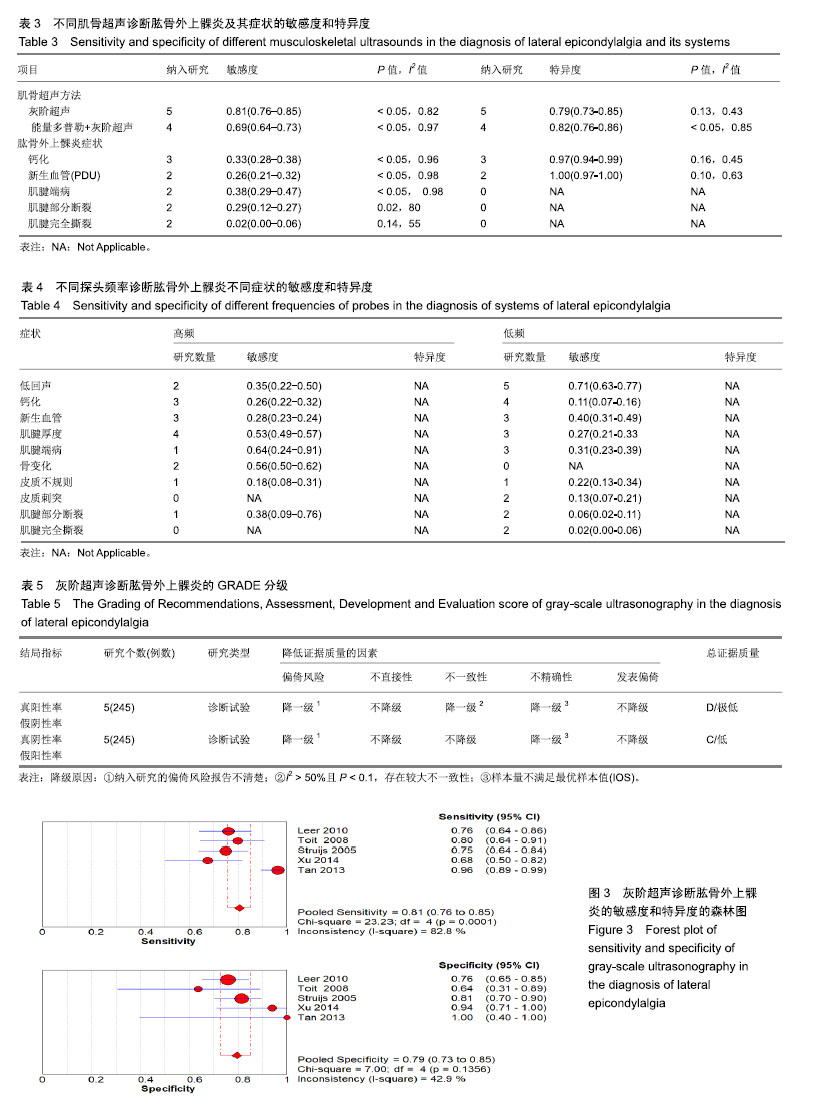| [1]Kwak SH, Lee SJ, Jeong HS, et al. Subtle elbow instability associated with lateral epicondylitis. BMC Musculoskelet Disord. 2018;19(1):136.[2]代飞,向明.肱骨外上髁炎病因与发病机制的研究进展[J].中华肩肘外科电子杂志,2017,5(2):142-144.[3]Arik HO, Kose O, Guler F, et al. Injection of autologous blood versus corticosteroid for lateral epicondylitis: a randomised controlled study. Orthop Surg. 2014;22(3):333-337.[4]Altinisik J, Meric G, Erduran M, et al. The BstUI and DpnII variants of the COL5A1 gene are associated with tennis elbow. Am J Sports Med. 2015;43(7):1784-1789.[5]Bao SS, Kapellusch JM, Merryweather AS, et al. Impact of Work Organizational Factors on Carpal Tunnel Syndrome and Epicondylitis. J Occup Environ Med. 2016;58(8):760-764. [6]López-de-Celis C, Barra-López ME, González-Rueda V, et al.Effectiveness of diacutaneous fibrolysis for the treatment of chronic lateral epicondylalgia: a randomized clinical trial.Clin Rehabil. 2018;32(5):644-653.[7]Shillito M, Soong M, Martin N. Radiographic and Clinical Analysis of Lateral Epicondylitis. J Hand Surg Am. 2017;42(6): 436-442.[8]赵亮,孔令跃,任逸众.等.肱骨外上髁炎研究进展[J]. 实用骨科杂志,2017,23(10):904-907.[9]Geoffroy P, Yaffe MJ, Rohan I.Diagnosing and treating lateral epicondylitis.Can Fam Physician. 1994;40:73-78.[10]Lebrun C: What are the best diagnostic criteria for lateral epicondylitis?//Evidence-based Orthopaedics: the Best Answers to Clinical Questions. Edited by Wright JG. London: Elsevier Health Sciences; 2008:148-157.[11]Matteo A, De Angelis R, Cipolletta E, et al. Systemic lupus erythematosus arthropathy: the sonographic perspective. Lupus. 2018;27(5):794-801.[12]Hamper UM, Dejong MR, Caskey CI, et al. Power Doppler imaging: clinical experience and correlation with color Doppler US and other imaging modalities. Radiographics. 1997;17(2): 499-513.[13]Whiting PF, Rutjes AW, Westwood ME, et al. QUADAS-2: a revised tool for the quality assessment of diagnostic accuracy studies. Ann Intern Med. 2011;155(8):529-536.[14]陈耀龙,姚亮,杜亮,等. GRADE在诊断准确性试验系统评价中应用的原理、方法、挑战及发展趋势[J]. 中国循证医学杂志, 2014, 14(11):1402-1406.[15]姚亮,陈耀龙,杜亮,等. GRADE在诊断准确性试验系统评价中应用的实例解析[J]. 中国循证医学杂志, 2014,14(11):1407-1412.[16]陈昊,王艳,胡轩铭,等. GRADE pro GDT在干预性系统评价证据质量分级中的应用[J]. 中国循证医学杂志, 2015,15(5): 600-606.[17]De Zordo T, Lill SR, Fink C, et al. Real-time sonoelastography of lateral epicondylitis: comparison of findings between patients and healthy volunteers. Am J Roentgenol. 2009; 193:180-185.[18]Noh KH, Moon YL, Jacir AM, et al. Sonographic probe- induced tenderness for lateral epicondylitis: an accurate technique to confirm the location of the lesion. Knee Surg Sports Traumatol Arthrosc.2010; 18:836-839.[19]Struijs PA, Spruyt M, Assendelft WJ, et al. The predictive value of diagnostic sonography for the effectiveness of conservative treatment of tennis elbow. AJR Am J Roentgenol.2005;185:1113-1118.[20]Obradov M, Anderson PG. Ultrasonographic findings for chronic lateral epicondylitis. JBR-BTR 2012;95:66-70.[21]Toprak U, Baskan B, Ustuner E, et al. Common extensor tendon thickness measurements at the radiocapitellar region in diagnosis of lateral elbow tendinopathy. Diagn Interv Radiol. 2012;18:566-570.[22]Lee MH, Cha JG, Jin W, et al. Utility of sonographic measurement of the common tensor tendon in patients with lateral epicondylitis. AJR Am J Roentgenol.2011;196: 1363-1367.[23]Zeisig E, Ohberg L, Alfredson H. Extensor origin vascularity related to pain in patients with tennis elbow. Knee Surg Sports Traumatol Arthrosc.2006;14:659-663.[24]Connell D, Burke F, Coombes P, et al. Sonographic examination of lateral epicondylitis. AJR Am J Roentgenol. 2001;176:777-782.[25]Du Toit C, Stieler M, Saunders R, et al. Diagnostic accuracy of power Doppler ultrasound in patients with chronic tennis elbow. Br J Sports Med.2008;42:872-876.[26]Levin D, Nazarian LN, Miller TT, et al. Lateral epicondylitis of the elbow: US findings. Radiology. 2005; 237:230-234.[27]Lin J, Fessell D, Jacobson J, et al. An illustrated tutorial of musculoskeletal ultrasonography: part 1, introduction and general principles. AJR Am J Roentgenol.2000;175:637-645.[28]Miller TT, Shapiro MA, Schultz E, et al. Comparison of sonography and MRI for diagnosing epicondylitis. J Clin Ultrasound.2002;30:193-202.[29]Zeisig E, Fahlstrom M, Ohberg L, et al. A two-year sonographic follow-up after intratendinous injection therapy in patients with tennis elbow. Br J Sports Med.2010; 44:584-587.[30]Tarhan S, Unlu S, Ovali Z, et al.Value of ultrasonography on diagnosis and assessment of pain and grip strength in patients with lateral epicondylitis. Turk J Rheumatol.2009; 24:123-130.[31]Maffulli N, Khan KM, Puddu G. Overuse tendon conditions: time to change a confusing terminology. Arthroscopy.1998;14: 840-843.[32]许华宁,殷立平,杨益虎,等. 彩色多普勒超声对肱骨外上髁炎的诊断价值[J]. 中华临床医师杂志(电子版), 2014,8(15):14-16.[33]谭庆亭,傅先水,柳曦,等. 超声对网球肘的诊断价值[J]. 中国超声医学杂志, 2013,29(10):924-928.[34]Valentin C Dones III, Karen Grimmer, Kerry Thoirs, et al. The diagnostic validity of musculoskeletal ultrasound in lateral epicondylalgia: a systematic review. BMC Medical Imaging. 2014; 14:10.[35]李智尧,张磊. 网球肘研究新进展[J]. 中国骨伤, 2011, 24(11): 969-972.[36]Clarke AW, Ahmad M, Curtis M, et al. Lateral elbow tendinopathy: correlation of ultrasound findings with pain and functional disability. Am J Sports Med.2010;38(6):1209-1214.[37]傅先水,刘吉斌,王金锐.等. 肌肉骨关节超声检查规范(草案)-美国超声医学会(AIUM)美国放射学会(ACR)制订[J]. 中华医学超声杂志(电子版),2010,7(1):141-152. |
.jpg)



.jpg)
.jpg)